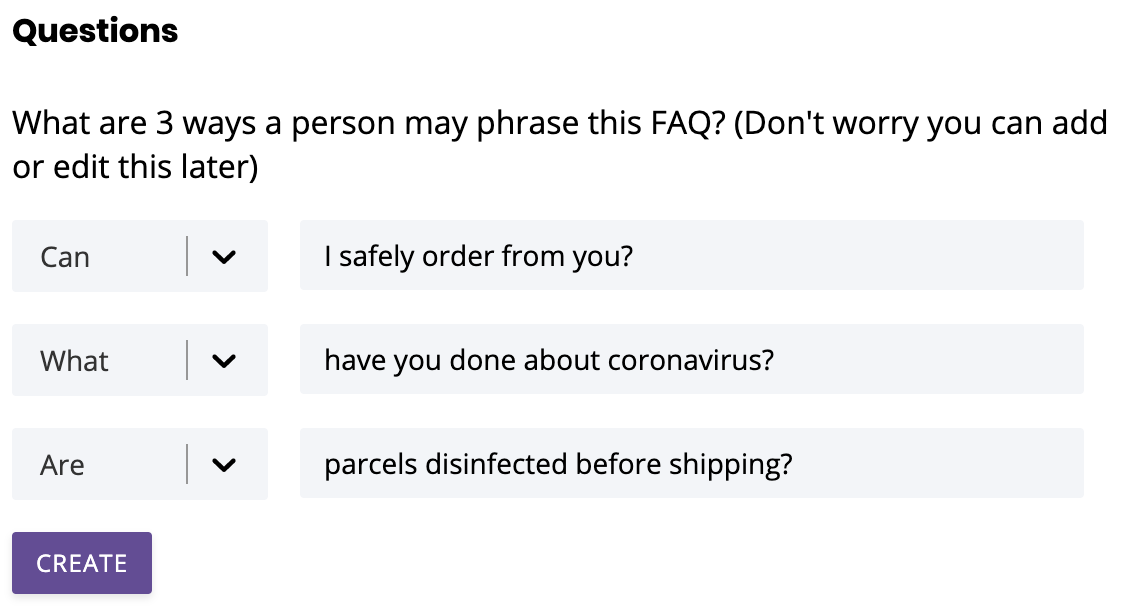Preparing for the Unknown with a Customer Service Chatbot

The unknown. A customer service nightmare.
The unknown will back up your phone lines and flood your inbox.
Whilst you can’t prepare for everything, you can utilise technology to reduce the impact. Not just after it arrives, but before as well.
Chatbots give you two powerful weapons against contact centre ‘surprises.’
- Flexibility
- Warnings
Here’s how to utilise a chatbot's flexibility and make the most of their warning capabilities.
Utilising the flexible nature of a chatbot
Let's take a worst case scenario. A huge problem has come to light and you’re about to be (or already are) inundated with disgruntled customers.
You’ll want to quickly train your chatbot on the new subject matter. This will give you a first line of defence, offering customers a way to get answers without contacting you directly.
When doing so, be sure to make the most of a chatbots ability to give both quick and thorough answers.
A chatbot can easily link to articles, PDFs and videos. This gives you a way to answer a customer's question and provide them with further reading.

Letting your chatbot deal with the brunt of enquiries takes pressure off your team, which is particularly useful when working with lower staff numbers.
How to quickly train a chatbot on a new issue
Training a chatbot is pretty simple. Start at the top and work down:
- What’s the issue?
- What will our answer be?
- How will people phrase the question?
In a real-world situation, this looks like:
The issue:
COVID-19 has led to an influx of customers asking about our delivery protocols.
Your answer:
“Upon reviewing the World Health Organisations advice, we are operating with reduced staff members. PPE is worn at all times and all equipment is regularly sanitised. For more information on the measures we’ve put in place, please see this article [example.com]”
Possible ways of phrasing the question:

This will give you a chatbot that’s able to advise on new delivery protocols due to the pandemic, with the option to update the answers it gives as time progresses.
Whilst being able to update your chatbot on the fly can be a saving grace during stressful times, there is more a chatbot can do to help.
Namely, a chatbot can warn you about issues, before you become swamped. Now that is truly innovative!
Using a chatbot to warn you of arising issues
It’s a lot easier to prepare for an issue when you know it’s coming. Here’s how to use a chatbot to see into the future.
When a customer runs into an issue, they’ll try and sort it out themselves (source).
If you’ve got a chatbot on your website, it’s likely to be one of the first things customers turn to.
When the customer asks your chatbot about the issue, you’ll get a record of the conversation.
This gives you an invaluable warning.
A few customers asking your chatbot how to add products to their basket? This could be a sign of a new technical bug.
Not every issue raised is going to be cause for alarm. You’ll need a system in place so you can easily spot the ‘one offs’ from the cause for concerns.
A step by step guide for using chatbot data to spot anomalies
Anomalies are the ‘one-offs’, the potentially huge problems that your chatbot receives.
Here's how to spot them:
- Monitor chatbot conversations - Look at the different questions users ask your chatbot, and which answers are most commonly given.
- Take note of frequency - Keep an eye on how many times your chatbot is asked the same question within a set time frame. This tells you which questions are commonplace. At ubisend, our chatbot dashboards are built with custom metrics that you’ve specified to make monitoring frequency hassle free.
We cover creating personalised, custom chatbot metrics in our free business chatbot course.
- Create new FAQs - When your chatbot gets asked something it hasn’t seen before, create a new FAQ. This grows your chatbot's capabilities, as it’s able to answer a wider range of questions, and gives you a heads up on a potential issue.
- Keep an eye on new questions - After you’ve created a new FAQ, keep an eye on how often it’s triggered. If this happens regularly, it could be a sign of a large issue developing.
- Notify relevant teams - We recommend having easy access to contact details for those responsible for your website, products, payments, and orders (as a minimum). This makes it simple to inform the relevant teams of the new issue, before it becomes a much larger problem.
Following this system will make it easy for you to spot a new issue as its arising, allowing you to act accordingly.
For an in-depth breakdown of monitoring your chatbots data, check out this webinar.
A customer service environment is a rewarding and often turbulent one. Through correct usage of available technology, you can put measures in place to help make it less turbulent.
By using a customer service chatbot, sudden traffic spikes become a lot less stressful and your new eyes into the future will help you remain prepared in the face of the unknown.
To get an expert's opinion on how to best use a chatbot in your department, have a quick chat with our team.












